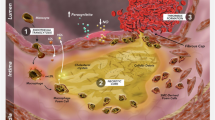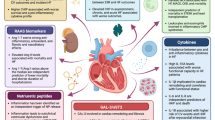Abstract
CD4+CD25+ regulatory T cells (Tregs) have been shown to protect against abdominal aortic aneurysm (AAA) progression. Statins have immunomodulatory properties, and their effect on AAA partly depends on immune-related mechanisms. In this study, we aimed to explore whether there is an association between statins and Tregs in AAA progression. Sixty ApoE−/− mice were randomly divided into four groups (n = 15 per group): A, saline group; B, control group; C, simvastatin group (intragastric administration of simvastatin); and D, PC61 group (simvastatin combined with an intraperitoneal injection of 100 μg CD25-depleting antibody PC61). After 2 weeks of simvastatin treatment, the mice received a continuous subcutaneous infusion of angiotensin II (Ang II; B, C, and D groups) or saline (A group) for 28 days. Simvastatin therapy for 6 weeks significantly decreased the incidence and severity of AAA and inhibited the apoptosis of smooth muscle cells and generation of reactive oxygen species, which was partly abolished after the injection of PC61 antibody. Importantly, simvastatin increased the number of Tregs and the levels of Treg-associated cytokines (TGF-β and IL-10) and decreased the level of IL-17 both in aortic tissues and serum. Interestingly, simvastatin attenuated Ang II-induced gut microbial dysbiosis, which might be associated with the accumulation of Tregs. In conclusion, simvastatin therapy prevented the development of AAA induced by Ang II in ApoE−/− mice, which might be partly due to the induction of Treg accumulation. In addition, simvastatin regulated gut microbial dysbiosis, which might also be associated with Treg generation.






Similar content being viewed by others
Data availability
The datasets used and/or analyzed during the current study are available from the corresponding authors on reasonable request.
References
Golledge J (2019) Abdominal aortic aneurysm: update on pathogenesis and medical treatments [J]. Nat Rev Cardiol 16(4):225–242. https://doi.org/10.1038/s41569-018-0114-9
Xiong X, Wu Z, Qin X, Huang Q, Wang X, Qin J, Lu X (2022) Meta-analysis suggests statins reduce mortality after abdominal aortic aneurysm repair [J]. J Vasc Surg 75(1):356–362 e354. https://doi.org/10.1016/j.jvs.2021.06.033
Takagi H, Yamamoto H, Iwata K, Goto S, Umemoto T, Group A (2012) Effects of statin therapy on abdominal aortic aneurysm growth: a meta-analysis and meta-regression of observational comparative studies [J]. EJVES 44(3):287–292. https://doi.org/10.1016/j.ejvs.2012.06.021
Li Y, Lu G, Sun D, Zuo H, Wang DW, Yan J (2017) Inhibition of endoplasmic reticulum stress signaling pathway: a new mechanism of statins to suppress the development of abdominal aortic aneurysm [J]. PLoS One 12(4):e0174821. https://doi.org/10.1371/journal.pone.0174821
Miyake T, Morishita R (2009) Pharmacological treatment of abdominal aortic aneurysm [J]. Cardiovasc Res 83(3):436–443. https://doi.org/10.1093/cvr/cvp155
Cepika AM, Sato Y, Liu JM, Uyeda MJ, Bacchetta R, Roncarolo MG (2018) Tregopathies: monogenic diseases resulting in regulatory T-cell deficiency [J]. J Allergy Clin Immunol 142(6):1679–1695. https://doi.org/10.1016/j.jaci.2018.10.026
Sakaguchi S, Miyara M, Costantino CM, Hafler DA (2010) FOXP3+ regulatory T cells in the human immune system [J]. Nat Rev Immunol 10(7):490–500. https://doi.org/10.1038/nri2785
Suh MK, Batra R, Carson JS, Xiong W, Dale MA, Meisinger T, Killen C, Mitchell J, Baxter BT (2020) Ex vivo expansion of regulatory T cells from abdominal aortic aneurysm patients inhibits aneurysm in humanized murine model [J]. J Vasc Surg 72(3):1087–1096 e1081. https://doi.org/10.1016/j.jvs.2019.08.285
Meng X, Yang J, Zhang K, An G, Kong J, Jiang F, Zhang Y, Zhang C (2014) Regulatory T cells prevent angiotensin II-induced abdominal aortic aneurysm in apolipoprotein E knockout mice [J]. Hypertension 64(4):875–882. https://doi.org/10.1161/HYPERTENSIONAHA.114.03950
Shahbaz SK, Sadeghi M, Koushki K, Penson PE, Sahebkar A (2019) Regulatory T cells: possible mediators for the anti-inflammatory action of statins [J]. Pharmacol Res 149(104469). https://doi.org/10.1016/j.phrs.2019.104469
Ait-Oufella H, Salomon BL, Potteaux S, Robertson A-KL, Gourdy P, Zoll J, Merval R, Esposito B, Cohen JL, Fisson S et al (2006) Natural regulatory T cells control the development of atherosclerosis in mice [J]. Nat Med 12(2):178–180. https://doi.org/10.1038/nm1343
King VL, Trivedi DB, Gitlin JM, Loftin CD (2006) Selective cyclooxygenase-2 inhibition with celecoxib decreases angiotensin II-induced abdominal aortic aneurysm formation in mice [J]. Arterioscler Thromb Vasc Biol 26(5):1137–1143. https://doi.org/10.1161/01.ATV.0000216119.79008.ac
Daugherty A, Manning MW, Cassis LA (2001) Antagonism of AT2 receptors augments angiotensin II-induced abdominal aortic aneurysms and atherosclerosis [J]. Br J Pharmacol 134(4):865–870. https://doi.org/10.1038/sj.bjp.0704331
Wu G, Chen T, Shahsafaei A, Hu W, Bronson RT, Shi GP, Halperin JA, Aktas H, Qin X (2010) Complement regulator CD59 protects against angiotensin II-induced abdominal aortic aneurysms in mice [J]. Circulation 121(11):1338–1346. https://doi.org/10.1161/CIRCULATIONAHA.108.844589
Kadoglou NP, Papadakis I, Moulakakis KG, Ikonomidis I, Alepaki M, Moustardas P, Lampropoulos S, Karakitsos P, Lekakis J, Liapis CD (2012) Arterial stiffness and novel biomarkers in patients with abdominal aortic aneurysms [J]. Regul Pept 179(1–3):50–54. https://doi.org/10.1016/j.regpep.2012.08.014
Knochelmann HM, Dwyer CJ, Bailey SR, Amaya SM, Elston DM, Mazza-McCrann JM, Paulos CM (2018) When worlds collide: Th17 and Treg cells in cancer and autoimmunity [J]. Cell Mol Immunol 15(5):458–469. https://doi.org/10.1038/s41423-018-0004-4
Xiong W, Mactaggart J, Knispel R, Worth J, Zhu Z, Li Y, Sun Y, Baxter BT, Johanning J (2009) Inhibition of reactive oxygen species attenuates aneurysm formation in a murine model [J]. Atherosclerosis 202(1):128–134. https://doi.org/10.1016/j.atherosclerosis.2008.03.029
Cheema MU, Pluznick JL (2019) Gut microbiota plays a central role to modulate the plasma and fecal metabolomes in response to angiotensin II [J]. Hypertension 74(1):184–193. https://doi.org/10.1161/HYPERTENSIONAHA.119.13155
Xie J, Lu W, Zhong L, Hu Y, Li Q, Ding R, Zhong Z, Liu Z, Xiao H, Xie D et al (2020) Alterations in gut microbiota of abdominal aortic aneurysm mice [J]. BMC Cardiovasc Disord 20(1):32. https://doi.org/10.1186/s12872-020-01334-2
Brown EM, Kenny DJ, Xavier RJ (2019) Gut microbiota regulation of T cells during inflammation and autoimmunity [J]. Annu Rev Immunol 37:599–624. https://doi.org/10.1146/annurev-immunol-042718-041841
Meng X, Zhang K, Li J, Dong M, Yang J, An G, Qin W, Gao F, Zhang C, Zhang Y (2012) Statins induce the accumulation of regulatory T cells in atherosclerotic plaque [J]. Mole Med (Cambridge, Mass) 18:598–605. https://doi.org/10.2119/molmed.2011.00471
Kim HJ, Hwang SJ, Kim BK, Jung KC, Chung DH (2006) NKT cells play critical roles in the induction of oral tolerance by inducing regulatory T cells producing IL-10 and transforming growth factor beta, and by clonally deleting antigen-specific T cells [J]. Immunol 118(1):101–111. https://doi.org/10.1111/j.1365-2567.2006.02346.x
Mucida D, Park Y, Kim G, Turovskaya O, Scott I, Kronenberg M, Cheroutre H (2007) Reciprocal Th17 and regulatory T cell differentiation mediated by retinoic acid [J]. 317(5835):256–260. https://doi.org/10.1126/science.1145697
Tang Y, Fan W, Zou B, Yan W, Hou Y, Kwabena Agyare O, Jiang Z, Qu S (2021) TGF-beta signaling and microRNA cross-talk regulates abdominal aortic aneurysm progression [J]. Clin Chim Acta 515:90–95. https://doi.org/10.1016/j.cca.2020.12.031
Angelov SN, Hu JH, Wei H, Airhart N, Shi M, Dichek DA (2017) TGF-β (Transforming growth factor-β) signaling protects the thoracic and abdominal aorta from angiotensin II-induced pathology by distinct mechanisms [J]. Arterioscler Thromb Vasc Biol 37(11):2102–2113. https://doi.org/10.1161/atvbaha.117.309401
Adam M, Kooreman NG, Jagger A, Wagenhauser MU, Mehrkens D, Wang Y, Kayama Y, Toyama K, Raaz U, Schellinger IN et al (2018) Systemic upregulation of IL-10 (Interleukin-10) using a nonimmunogenic vector reduces growth and rate of dissecting abdominal aortic aneurysm [J]. Arterioscler Thromb Vasc Biol 38(8):1796–1805. https://doi.org/10.1161/ATVBAHA.117.310672
Chang TW, Gracon AS, Murphy MP, Wilkes DS (2015) Exploring autoimmunity in the pathogenesis of abdominal aortic aneurysms [J]. Am J Physiol Heart Circ Physiol 309(5):H719-727. https://doi.org/10.1152/ajpheart.00273.2015
Teo F H, de Oliveira R T D, Villarejos L, Mamoni R L, Altemani A, Menezes F H, Blotta M (2018) Characterization of CD4(+) T cell subsets in patients with abdominal aortic aneurysms [J]. Mediators Inflamm 6967310. https://doi.org/10.1155/2018/6967310
Liao M, Liu CL, Lv BJ, Zhang JY, Cheng L, Cheng X, Lindholt JS, Rasmussen LM, Shi GP (2015) Plasma cytokine levels and risks of abdominal aortic aneurysms: a population-based prospective cohort study [J]. Ann Med 47(3):245–252. https://doi.org/10.3109/07853890.2015.1019916
Wei Z, Wang Y, Zhang K, Liao Y, Ye P, Wu J, Wang Y, Li F, Yao Y, Zhou Y et al (2014) Inhibiting the Th17/IL-17A-related inflammatory responses with digoxin confers protection against experimental abdominal aortic aneurysm [J]. Arterioscler Thromb Vasc Biol 34(11):2429–2438. https://doi.org/10.1161/atvbaha.114.304435
Yang T, Santisteban MM, Rodriguez V, Li E, Ahmari N, Carvajal JM, Zadeh M, Gong M, Qi Y, Zubcevic J et al (2015) Gut dysbiosis is linked to hypertension [J]. Hypertension 65(6):1331–1340. https://doi.org/10.1161/HYPERTENSIONAHA.115.05315
Vieira-Silva S, Falony G, Belda E, Nielsen T, Aron-Wisnewsky J, Chakaroun R, Forslund SK, Assmann K, Valles-Colomer M, Nguyen TTD et al (2020) Statin therapy is associated with lower prevalence of gut microbiota dysbiosis [J]. Nature 581(7808):310–315. https://doi.org/10.1038/s41586-020-2269-x
Funding
This work was supported by the grants of the National Natural Science Foundation of China (No. 81970319) and the Taishan Scholars Program of Shandong Province (No. tsqn202103170).
Author information
Authors and Affiliations
Contributions
XM and YZ designed the study. LLM performed the experiments, analyzed the data, and wrote the manuscript. YL, XLW, and XG contributed to the performing of the experiments. WHS and MZ contributed in the revision of the manuscript. All the authors read and approved the final manuscript.
Corresponding authors
Ethics declarations
Ethics approval
Animal care and experimental procedures were approved by the Animal Ethics Committee of Shandong University and performed according to the Animal Management Rules of the Chinese Ministry of Health.
Competing interests
The authors declare no competing interests.
Additional information
Publisher's Note
Springer Nature remains neutral with regard to jurisdictional claims in published maps and institutional affiliations.
Key messages
• Simvastatin therapy protected against AAA development in ApoE-/- mice by inducing the accumulation of Tregs in aortic tissues, which decreased the SMC apoptosis of smooth muscle cells and ROS generation.
• The accumulation of Tregs in aortic tissues promoted local anti-inflammatory responses.
• The accumulation of Tregs in aortic tissues may be partly related to the improvement of gut microbiota induced by simvastatin therapy.
Supplementary information
Below is the link to the electronic supplementary material.
Rights and permissions
About this article
Cite this article
Meng, L., Lu, Y., Wang, X. et al. Statin therapy protects against abdominal aortic aneurysms by inducing the accumulation of regulatory T cells in ApoE−/− mice. J Mol Med 100, 1057–1070 (2022). https://doi.org/10.1007/s00109-022-02213-3
Received:
Revised:
Accepted:
Published:
Issue Date:
DOI: https://doi.org/10.1007/s00109-022-02213-3




